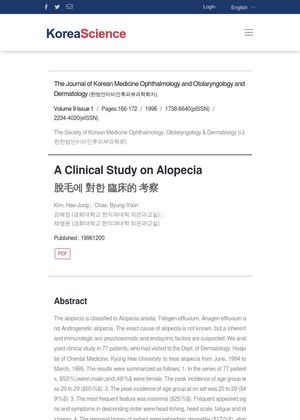A Clinical Study on Alopecia
January 1996
in “
The Journal of Korean Medicine Ophthalmology and Otolaryngology and Dermatology
”

TLDR The study found that the most common symptom of alopecia was insomnia and the most used treatment was Shineung Yangjin Dan.
In a clinical study conducted from June 1994 to March 1995, 77 patients suffering from various types of alopecia were analyzed at the Dept. of Dermatology, Hospital of Oriental Medicine, Kyung Hee University. The patients were almost evenly split between males (52%) and females (48%), with the highest incidence in the 20 to 29 age group (55%). The most common symptom was insomnia (25%), followed by head itching, head scale, fatigue, and dizziness. Personal medical history revealed that 17% of patients had seborrheic dermatitis, with other conditions including atopic dermatitis, thyroid gland disorders, and acne. A family history of alopecia was present in 25% of patients. The most commonly used treatment was Shineung Yangjin Dan, used in 36% of cases.



